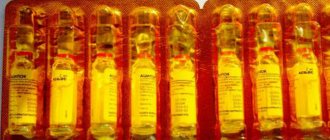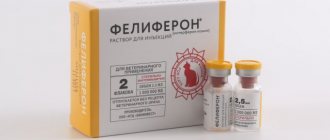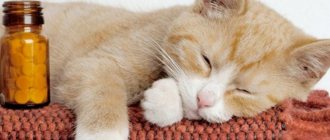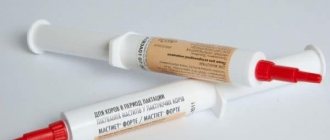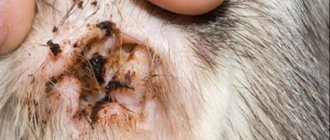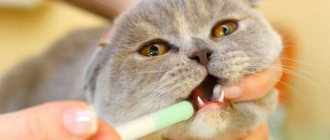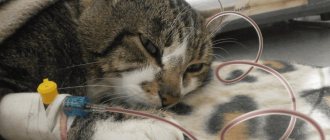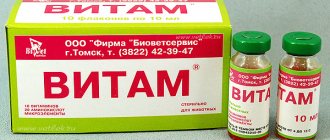What is madder
Madder (popularly known as crapp) is a perennial herbaceous plant that can be found in Georgia, Azerbaijan, Dagestan, and the Crimea.
The plant got its name because of the red pigment contained in the root system. Madder was first used in industry for dyeing fabrics (wool, linen, cotton).
The popular name for madder is krapp.
Both the aerial part of madder and the root have healing properties. But in the treatment of urolithiasis in cats, it is the rhizomes that are used, which are quite powerful in this plant.
To treat urolithiasis in cats, preparations based on madder roots are used.
Medicinal properties of the plant
Madder has a complex of medicinal properties that are useful specifically for the functioning of the urinary system:
- bactericidal - has a detrimental effect on various types of cocci (spherical bacteria);
- anti-inflammatory and antispasmodic - relieves pain that occurs when small stones and sand move through the ureters;
- diuretic - activates the process of urination, helping to wash out small stones.
Madder also affects oxalate and phosphate stones, helping to soften and crush them.
Healing capabilities of the plant
Madder has a unique ability to soften, destroy, dissolve and remove almost all types of stones from the body. It has antispasmodic, astringent, choleretic, diaphoretic and diuretic properties. In this regard, it can be used to treat:
An infusion of madder roots can be used as a diuretic and laxative, for inflammation of the spleen and for delayed menstruation.
Decoctions from the roots are used to remove salts from the joints of the hands and feet, for polyarthritis and osteochondrosis.
Experts prescribe tablets based on madder for the following conditions and diseases:
- To facilitate the passage of small stones, sand and reduce spasms during urolithiasis.
- If it is not possible to perform surgical intervention for renal nephrourolithiasis.
- For the treatment of urinary tract infections.
- With inflammatory phosphaturia.
- Before surgery.
- To prevent relapses after surgery.
The drug is used strictly as prescribed by the doctor. The most commonly recommended dose is one tablet three times a day. For better absorption, the tablets are pre-dissolved in water.
In some cases, a single dose can be increased to two to three tablets. The course of therapy with natural medicines ranges from 20 to 30 days. You can repeat it after 5-6 weeks, but only after consulting a doctor.
We invite you to familiarize yourself with the List of Antibiotics for Cystitis in Cats
Chemical composition of madder
The root system of the plant contains the following substances:
- acids: citric - improves metabolic processes in cells;
- wine - helps normalize digestion;
- apple - regulates metabolic processes in the body;
- ascorbic acid - lowers the level of uric acid in the body, protects cells from damage.
Forms of release of the drug
The drug can be purchased at a regular pharmacy. Madder is available in different forms:
- Pills. Packed in blister and cardboard box. Packaging: 10–60 pieces. One tablet contains 250 mg of active substance (madder dry extract). The tablets are round in shape and have a line in the middle. The color can vary from light to dark brown with patches, a pinkish tint is possible. The price for a package of 10 tablets is from 60 rubles.
- Drops. A more convenient form for use and dosing of the drug. Available in a 50 ml plastic bottle, packed in a cardboard box. The drug costs about 200 rubles.
- Chopped root. This is the raw material for preparing medicinal infusions and decoctions. The root is packaged in 50 g packets in paper or plastic bags. The drug costs from 50 rubles.
- Herbal tea. Contains tea bags for brewing in a mug. 20 filter bags are packed in a cardboard box. Its cost is about 120 rubles.
The drug is produced for humans and is sold in regular pharmacies. But it has also found its application in veterinary medicine. For cats, tablets are most often used or infusions and decoctions are prepared from the crushed root.
Photo gallery: madder preparations in different release forms
Madder drops help dissolve calcium oxalates
Tablets containing extract of madder are the most common form of the drug used in the treatment of cats. Infusions and decoctions are prepared from the crushed roots of madder.
It is convenient to brew herbal tea in a mug, but it is more difficult to dose for cats
Composition, description and packaging
Veterinarians widely use madder to treat cats suffering from urolithiasis. Few pet owners know about its healing properties. This is a herbaceous medicinal plant. For therapy, rhizomes are used, which contain a large amount of biologically active substances (citric, tartaric, malic acids, anthraquinones), vitamins (vitamin C) and minerals (iron, copper).
Madder is effectively used to treat not only people, but also cats, as it replaces several medical procedures. The plant has anti-inflammatory and bactericidal effects against the coccal group of microorganisms. The active substances of Madder help the breakdown of urate, phosphate and oxalate stones and their removal by activating urination, reducing spasms and activating muscle peristalsis of the pelvis and ureters. Reduces dull pain in the kidneys and during urination.
The drug madder (tablets), reviews of which are controversial, goes on sale in blister packaging. One cardboard pack can contain from 10 to 60 tablets (250 mg each).
The drug in question has a light brown or brown color, as well as inclusions and a mark in the middle.
The active substance of this medicine is the dry extract of madder. In addition, the tablets also contain additional elements such as potato starch, colloidal silicon dioxide, lactose (or so-called milk sugar), calcium stearate and croscarmellose sodium.
Indications for use for cats
Madder extract is used to treat urinary tract diseases in cats. This is usually accompanied by the following symptoms:
- increased frequency of urination, with little urine being released (sometimes just a few drops);
- the appearance of impurities in the urine (blood, pus, sand);
- cloudy urine (contains impurities that are not visible to the human eye);
- increased body temperature (above 39 degrees);
- lack of appetite, lethargy.
Video: urolithiasis in cats
Urolithiasis is a common disease in cats.
Unfortunately, even our pets suffer from various diseases, including diseases of the urinary system.
Due to hypothermia, unclean water, bacteria entering the animal’s body, and poor nutrition, the animal’s kidneys and bladder suffer.
Due to hypothermia, the cat's kidneys begin to suffer.
In this case, it is better not to delay treatment so that the disease does not cause complications.
Main symptoms of urolithiasis
- urine mixed with pus, blood, sand, or suspiciously cloudy urine (for example, a pronounced yellow color indicates the presence of a large amount of salts and alkalis);
- frequent urges of the animal to go to the toilet;
- lack of urine, or small portions of excreted fluid;
- lack of appetite;
- apathy;
- temperature increase.
Urine with blood is a symptom of urolithiasis.
In this case, it is better not to postpone a visit to the veterinarian. If delayed, the disease may worsen, and the pet will have to have catheters placed for some time. Owners can also try using traditional medicine methods - for example, making a decoction of madder.
Instructions for use and dosage of madder for the treatment of cats
Treatment of urolithiasis is a complex process that requires a set of measures. It must be carried out under the supervision of a specialist. Therefore, independent use of madder for your pet is highly not recommended.
The use of madder depends on the specific form of the drug.
The drug is approved for use in kittens from 1 month of age.
Pills
Madder tablets are most often purchased for the treatment of cats:
- The tablet is divided into 4 parts.
- 1/4 is crushed, diluted in 25 ml of boiled water.
- Draw the resulting solution into a syringe without a needle at the rate of 1 ml per 1 kg of pet’s weight.
- The drug is poured from a syringe into the pet’s mouth 2 times a day before meals.
- The course of treatment is 1–2 months. Improvements in the condition are usually noticeable starting from the 3rd day of treatment.
In case of a complex course of the disease (for example, when there is no urination at all), an intensive course of therapy is carried out. The drug is calculated at 2 ml per 1 kg of weight, and is given to the cat 4 times a day. This dosage and frequency continue for 4 days, after which they switch to the standard regimen.
Video: how to give liquid medicine to a cat
How to prepare and use decoction and infusion
To prepare a decoction, crushed roots of the plant are used:
- 1 tbsp. l. roots are poured with a glass of boiling water.
- Keep on low heat for 10 minutes.
- Take 10 ml from the resulting decoction and dilute it with 100 ml of boiled water.
- The cat is given 2 ml 2 times a day before meals.
The drug is given to the cat from a syringe without a needle.
You can also prepare an infusion. It is recommended to make it from madder root powder:
- 1 teaspoon of powder is poured into a glass of cold water and left for 8 hours.
- Then it is filtered, the resulting liquid is set aside, and the sediment is poured again, but with a glass of boiling water for 15 minutes.
- Strain and mix both resulting liquids in one container.
- The dosage and regimen are identical to the decoction.
When to expect treatment results
If you adhere to the correct dosage and give the medicine to your cat regularly, then after 5-6 days you will be able to observe an improvement in its condition.
We invite you to familiarize yourself with the Sumatran Barbus - contents, compatibility, reproduction, photos
Taking the drug should continue until complete recovery - approximately, the period will be about a month. Longer treatment is often required.
Many cat owners note that thanks to moraine, the disease can be managed 100%, and relapses are not observed.
The main thing is that the dosage of the drug is not violated. To avoid harm to your pet, treatment should be started only after consultation with a veterinarian.
Attention! You should not look in the pharmacy for a special madder-based drug intended for the treatment of cats. You can buy regular tablets that are used by people; they are perfect for animals.
Contraindications and side effects
Side effects include allergic reactions. During treatment, urine may turn pink, which is normal. But if the urine turns brown, then the dosage of the drug should be reduced, and if the symptom does not go away even after that, it should be discontinued.
Contraindications for use are:
- glomerulonephritis both in the chronic phase and in the acute stage;
- renal failure;
- stomach ulcer;
- lactase deficiency;
- allergy to the drug;
- period of pregnancy and lactation in cats.
Owner reviews
Since May, we have lived not for ourselves, but just to prevent the cat from dying. Lots of money for various medications, procedures, catheters, the torment of the cat and our hysterics, because it is impossible to look at all this calmly. Probably as a reward for her efforts, my mother came across a forum, where she learned about the properties of madder. There was nothing to lose, so I started giving the cat water. The cat recorded himself for the first time in 2.5 months!!!! First in small puddles, then more and more. Now almost all the urine is coming out. I can’t even believe that after so much time and medications that didn’t help, the herb helped and so quickly.
Two years ago, my cat fell ill with urolithiasis, and half a year later my second cat fell ill. We did everything possible. Ultrasound, all tests, changed the diet of porridge, meat, baby food, mineral water for drinking, cyston medicine, no-spa, etc. The symptoms were like everyone else, painful urination, urinary retention, cloudy urine, blood in urine, they practically did not part with the catheter. In general, nothing helped, my heart broke looking at how my pets were suffering, and I couldn’t help in any way until one person, a doctor from a military hospital, advised me to use a very good medicine - madder extract. For my pets, the first improvements came after 4 days, and for a year and a half now everything has been fine with us, there has not been a single relapse.
I would prefer madder in its homeopathic form, but in decimal (low dilutions) 1X - 3X. , when the material content of madder is still quite noticeable, but there is very little of it there. You can make this drug yourself. Since you are unlikely to find such a low dilution in a homeopathic pharmacy. 1 tbsp. Brew a spoon into a glass of boiling water. Then take 10 ml of the decoction and dilute it with 100 ml of boiled water. Give the animal 2 ml of this solution 2 times a day for 2 weeks.
Madder is a good drug. But if you dilute it and pour it into your mouth for a month, your tooth enamel will loosen. People swallow it whole, without holding it in their mouth, but the cat will resist and try to “spit it out.” Therefore, it is better to divide it in “dry” form and into the root of the tongue. Next, pour in some water.
We tried a lot, but MARENA KRASIILNAYA really helped us. I found it on my own, as a result of long wanderings on the Internet, collecting information bit by bit. Of course, everything has been agreed upon with the doctor; self-medication is out of the question. The stones dissolved and came out as sand. After a couple of months, the tests were perfect. I have been feeding her cat for over a year, in courses, since the peculiarity of the cat’s metabolism is such that stones form again. So far it has not been possible to correct it. We have oxalates. After taking madder, a few days later the sand begins to intensively come off, I see quite clearly that there are ways. Probably, its effect is not equally effective in all cases, but you can try. If done carefully and under control, there will be no harm, for sure.
Madder has long been used to treat urolithiasis in animals, although this drug was created for humans. But treatment of a pet should only be carried out under the supervision of a specialist. During the therapy process, do not forget about the pet’s compliance with the diet and other recommendations of the veterinarian.
ICD in a cat
The term urolithiasis or urolithiasis by doctors refers to the formation of urinary stones (or sand) in the kidneys, bladder or their retention in the lumen of the ureters and urethra. Urinary stones occur in all domestic animals, but are more common in cats and dogs. The chemical composition of such stones is very diverse, for example, they may include uric acid, urates, oxalates, carbonates, phosphates, cystine, xanthine, etc. Along with this, the number of stones formed in the urinary organs ranges from one to one hundred or more. Their size also varies widely (from a millet grain to the size of a large walnut). Etiology What causes the formation of such stones? Unfortunately, there cannot be a clear answer to this question. However, today it has been established that possible predisposing factors for the appearance of insoluble compounds in urine are: genetic predisposition, animal diet, lifestyle (immobility, obesity), infectious agents, systemic diseases. In addition, domestic cats, descended from desert ancestors, easily maintain fluid balance in the body. This reflects their ability to produce highly concentrated urine. This exceptional ability may be a major factor in their development of urolithiasis. It should be noted that in cats the diameter of the urethral lumen is more than three times smaller than in cats. This causes more frequent clinical manifestations of urolithiasis. Uroliths can form in urine under the following conditions: 1. Chemical components of uroliths are present in the urine in concentrations exceeding the possibility of their dissolution, which contributes to the loss of crystals that collect in microstones. 2. A certain pH of urine, often alkaline. 3. The formation of crystals must occur quickly enough so that they cannot be washed out by the separated urine from the urinary tract. 4. The presence of a nucleus (matrix) for the formation of crystals, which can be cell remains, foreign bodies, bacteria and, possibly, viruses. 5. Bacterial flora may predispose to some forms of urolithiasis, because. It is during the life processes of organisms that insoluble mineral compounds are actively synthesized. Clinical symptoms Symptoms of urolithiasis depend on the shape, size and location of the stones. The disease may not manifest itself externally if the stones do not clog the lumens of the urethral canal and do not have sharp edges that would cause mechanical damage to the mucous membrane. Sometimes, when carrying out visual diagnostic methods, large stones were found in animals, more than two centimeters in diameter. The formation time of such a stone is at least one and a half years. However, during this period no complaints or signs of illness were observed. Urolithiasis in cats manifests itself only when there is difficulty urinating, in which the animal strains, often takes an appropriate position, and urine is released in a very weak stream, often with blood, at times interrupted or completely stopped. Urine often contains fine sand. Diagnostics When making a diagnosis, the veterinarian takes into account clinical signs, the results of a survey of the animal owners, laboratory tests of urine, and without fail carries out x-ray and ultrasound examinations, because similar symptoms can occur: when the lumen of the urethra is compressed by a tumor, inflammatory edema, and blood in the urine and pain can occur with acute cystitis, hemolysis, etc. Urolithiasis: treatment Treatment of the disease in question comes down to the following principles: 1. Relieving the acute condition and restoring the outflow of urine. To do this, it is necessary to remove stone or sand from the urethra with a catheter and rinse the lumen of the urethra with an antiseptic solution (done under general anesthesia). In advanced cases, doctors are forced to resort to urethrostomy surgery (creation of an artificial outlet channel to the area of obstruction). Even more difficult is abdominal surgery - cystotomy, the purpose of which is the complete removal of large uroliths (the diameter of which is larger than the lumen of the urethra) from the bladder. 2. After restoring the outflow of urine, infusion therapy (drip) is necessary during the first few days in order to restore water-electrolyte balance and relieve intoxication. Anti-inflammatory and antibacterial therapy is also carried out (up to two weeks). 3. After stabilization of the condition, lifelong prevention is mandatory: diet therapy - medicinal food, if necessary, antibiotic therapy, herbal medicine (diuretics, etc.), as well as regular medical examination: urine analysis and ultrasound of the kidneys and bladder. In each case, treatment is selected individually, taking into account gender, age, type of animal, degree of damage, presence of concomitant diseases, and must necessarily be based on detailed diagnostics. The most correct approach to the problem of urinary stones is the prevention of this pathology. For this purpose, the conditions for feeding and watering the animal are improved. Avoid prolonged use of monotonous foods rich in salts (fish, milk, various seafood, mineral supplements, etc.), as well as hard drinking water. The diet is enriched with vitamins, and when feeding a pet dry food, food marked “for castrated animals” or “for the prevention of urolithiasis” is used. We recommend that owners be more attentive to the health of their pets and respond quickly when unwanted symptoms appear, thereby preventing the development of a serious pathology that requires serious intervention.
Madder for cats
Madder for the treatment of cats
The healing herb madder for the treatment of cats with diseases of the urinary system is used quite successfully and effectively in veterinary practice.
Madder extract is extracted from the roots and rhizomes of the plant. The unique composition contained in the roots helps to crush and remove kidney stones. The dry extract of the plant eliminates smooth muscle spasms and activates the diuretic process. Promotes the destruction of stones consisting of particles of magnesium and calcium.
The dry extract has a strong diuretic and antispasmodic effect. After taking the tablets, the frequency of urination increases, and at the same time cloudiness of the urine is recorded, which is explained by the release of destroyed stones or sand.
Chemical composition of the plant
The root of the plant contains:
- malic, tartaric and citric acids;
- sugar;
- proteins;
- vitamin C;
- pectin substances;
- anthraquinones.
In the above-ground part of madder there are:
- carbohydrates;
- coumarins;
- flavonoids;
- routine
The underground part of the plant is used for medicinal purposes. Useful elements are preserved if the plant is collected and prepared correctly, according to the requirements. Harvesting roots should be done in early spring or late autumn. The roots are dried at a temperature of 45 degrees.
Action
The active components of the plant have a bactericidal effect and are effective against coccal bacteria. The plant helps to enhance peristaltic contractions of the muscles of the renal pelvis and ureters. Over time, the components of madder destroy urates in the kidneys and bladder and help eliminate them naturally.
Using the plant increases stomach acidity.
Madder activates the water-salt balance in the body of cats, relieves pain in the kidneys during urination, and promotes the promotion of urinary stones.
The use of this plant replaces certain medical procedures.
A few hours after consuming madder, the color of the urine turns red. This change lasts throughout the day.
Dosage and instructions for use
To treat cats, you need to take regular tablets produced for humans. The dose is determined according to the weight of the pet (1 ml per 1 kg of weight). It is recommended to take a quarter of one tablet for adults, and for a kitten the dose is a sixth of a tablet.
The medicine is diluted in a small amount of water (25 ml). The water should be boiled and cooled to room temperature.
The resulting solution should be given to a sick pet in the morning and evening. To accurately determine the amount, use a syringe with the needle removed.
When the cat’s disease is chronic or in the acute phase, the dose is doubled. When the escalation of the disease is overcome, you need to return to the original dose.
The duration of treatment is at least 30 days, in some cases 2 months, to avoid relapses.
It is not recommended to stop treatment or reduce the dose of medication arbitrarily, as the disease may worsen again.
A fresh solution of madder tablets is prepared at least once every 2 days.
It is normal for an animal’s urine to turn red after taking the medication. If the color of the urine becomes brown, this indicates an increased dose for the pet and an urgent need to adjust the daily dose. When, after reducing the dose, the color of the urine does not acquire a lighter shade, you should stop using the drug.
Basically, the first signs of improvement are recorded on the fifth day after starting to take the solution.
Features of application
The choice of medication form is determined by the location of the stones and the severity of the disease.
Pills
It is mainly in this form that madder is used when it is necessary to treat cats for urolithiasis. Step by step usage:
- You will need one quarter of a tablet.
- This part of the tablet must be crushed (in a mortar).
- In order for the medicine to be better absorbed, the crushed tablet must be dissolved in 20 ml (a tablespoon) of boiled water at room temperature.
- Calculate the volume (dosage) of the resulting solution for a single dose: 1 ml of liquid is required per 1 kg of cat weight.
- To accurately dose the solution, it is better to use a medical syringe without a needle. Use a syringe to draw up the required volume of liquid and carefully pour it into the cat’s mouth.
- The animal should be given the extract solution 2 times before meals, in the morning and in the evening. Place the container with the remaining solution in the refrigerator.
Improvement from the medicine occurs in the cat on the 3rd–5th day. Treatment of the disease should last 1–2 months. Treatment should not be interrupted or reduced to avoid exacerbation of the disease. The madder solution must be used fresh, so it is prepared every two days.
Contraindications
Madder dye is not allowed to be used for:
- Glomerulonephritis, both in the acute phase and in the chronic form;
- Severe renal failure;
- Stomach ulcer;
- Lactose deficiency;
- Hypersensitivity to the components of the drug.
The medicine should not be given to cats during lactation and pregnancy.
There are no special instructions prohibiting the use of madder with other drugs. The medicine can be used from 1 month of the kitten’s life.
The possibility of using an extract from the roots of madder for small kittens, its natural origin, and reasonable cost make the product one of the best among drugs with a similar purpose.
About catheterization of cats
As for the catheter that veterinarians may suggest you use, you should know: in cats, the urethra is smaller in diameter and longer than in cats, so catheterization is much more painful. As a result, due to injury from the catheter and escaping sand, the mucous membrane of the urethra swells, and the urethra becomes even narrower.
We invite you to familiarize yourself with bladder paresis, is there hope?
In this regard, if your cat has a catheter, you may not see quick results from using madder: the sand dissolved by the medicine is in the urine, and it is difficult for it to come out.
And in general: you should be extremely careful with catheterization, because an inexperienced veterinarian can pierce the urethra with a catheter, and then the situation will worsen.
Reviews from veterinarians
Elena Genadyevna. Veterinarian:
In modern veterinary practice, MB in cats is common. The fact is that most pets eat dry food, lead a sedentary lifestyle, and undergo castration or sterilization procedures.
Treatment and prevention with madder extract allows you to quickly and without harm to your pet’s health get rid of severe pathologies with dangerous consequences.
The drug allows you to naturally remove stones from the body in a short period of time and return your beloved pet to an active life. A proven product that can be purchased at any pharmacy; use does not require any skills.
Igor Vladislavovich. Veterinarian:
Madder tablets are obtained by extracting from the roots of the plant. You need to take the pills strictly according to the dose, so that signs of an overdose in the form of an allergy do not appear.
The use of madder can replace several medical procedures at once. A special feature of the drug is its ability to remove not only oxalates, but also urates and salts.
An excellent product with high performance.
